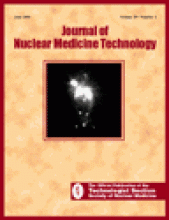Abstract
Extraskeletal myxoid chondrosarcoma of the lower extremity is rare, and slowly progressive. The authors of this article present the case of a man with progressive enlargement of the right thigh that underwent bone scintigraphy. The bone images showed a diffuse, moderate increase in uptake in the swollen right thigh. Despite chemotherapy, the patient died 28 mo later. At autopsy, it was confirmed that he had extraskeletal myxoid chondrosarcoma of the right thigh, which had metastasized to the upper arms, left scapula, lungs, pleurae, and right lower quadrant of the abdomen. The myxoid chondroid matrix, a major feature of the extraskeletal myxoid chondrosarcoma, is thought to account for the localization of the bone-imaging agent.
A 75-y-old man complained of dull pain in the right thigh. On physical examination, the right thigh was swollen and firm and a large immovable mass was felt in the middle. The patient was referred for bone scintigraphy. Anterior and posterior 99mTc HMDP (hydroxylmethylene diaphosphonate) whole-body bone images showed diffusely and moderately increased uptake in soft tissues of the right thigh (Fig. 1). An incisional biopsy of the mass was performed, and showed tumor elements consistent with myxoid chondrosarcoma (Figs. 2A and Figure 2B). The patient underwent chemotherapy with adriamycin, actinomycin D, cytoxan, and vincristine, but died 28 mo later. At autopsy, the tumor was confirmed to be an extraskeletal myxoid chondrosarcoma, which had metastasized to the upper arms, left scapula, lungs, pleurae, and right lower quadrant of the abdomen.
Anterior and posterior 99mTc HMDP whole-body bone images show moderately diffusely increased uptake in soft tissues of the right thigh as indicated by open arrows.
(A) The photomicrograph (500 × magnification, hematoxylin-eosin stain) of biopsy tissue shows abundant chondroid matrix surrounding irregular arrangement of tumor cells with vaculoid cytoplasm. (B) The photomicrograph (500 × magnification) shows lobular arrangement of tumor cell with myxo-chondroid matrix. Note string-like growth pattern of tumor cells radiating into matrix. These findings were consistent with myxoid chondrosarcoma.
DISCUSSION
Extraskeletal myxoid chondrosarcoma is an uncommon entity occurring primarily in the deep soft tissue of the extremities. It usually afflicts individuals older than 35 y of age, and males are more frequently affected than females (1). This tumor has the potential to recur and metastasize. The clinical and histologic features of extraskeletal myxoid chondrosarcoma corresponded well with the histology of this case. Bone-imaging agent localization in such a tumor has been reported (2–4). The exact mechanism of bone-imaging agent uptake by extraskeletal myxoid chondrosarcoma is not clear; it may be contributed by hyperemia, calcification, enchondral ossification in the tumors, and reactive new bone formation (2–4). There are 2 hypotheses of the bone agent uptake mechanisms of phosphonate compounds: hydroxyapatite uptake and collagen uptake (5). In the collagen uptake theory, it has been suggested that 99mTc phosphonate complex localizes in both inorganic and organic matrices of bone, the latter uptake depending on the amount of immature collagen present (5). This is an analogue of the bone scan of a patient with chondrosarcoma in the femur that showed increased uptake (6).
In this case, there was no evidence of calcification or new bone formation on the histologic examination; however, the histopathologic picture of the myxoid chondroid matrix (6), as shown on Figure 2, could explain avid uptake of the bone-imaging agent. In a chondrosarcoma of the femur, increased uptake in the lesion on the bone scintigraphy was demonstrated and chondroid matrix was an essential feature (6). In this patient, myxoid chondroid matrix was the site of bone-imaging agent localization in a chondrosarcoma of the femur.
Despite chemotherapy, extensive metastases developed in the patient’s upper arms, left scapula, lungs, pleurae, and right lower quadrant of the abdomen as evident at autopsy, and he expired within 28 mo. In the article titled, “Microvasculature and vascular endothelial growth factor (VEGF) expression in cartilaginous tumors,” Ayal et al. determined the presence of intracartilage vessels and VEGF expression by malignant chondrocytes (7). Their study demonstrated that angiogenesis is thought to be a vital process of cartilaginous tumors (7), and angiogenesis inhibition is important in the preservation of intact cartilage. Therefore, utilization of angiogenesis inhibition may be explored.
Footnotes
For correspondence or reprints contact: Dr. Wei-Jen Shih, MD, Nuclear Medicine Service, Lexington VA Medical Center, Lexington, KY 40511.









